
|
 |
Helicopter Work Horse The Piasecki H-21 by Scott Schwartz |
 |
 |
 |
 |
 |
|---|---|---|---|---|---|---|---|
 |
 |
 |
 |
 |
|||
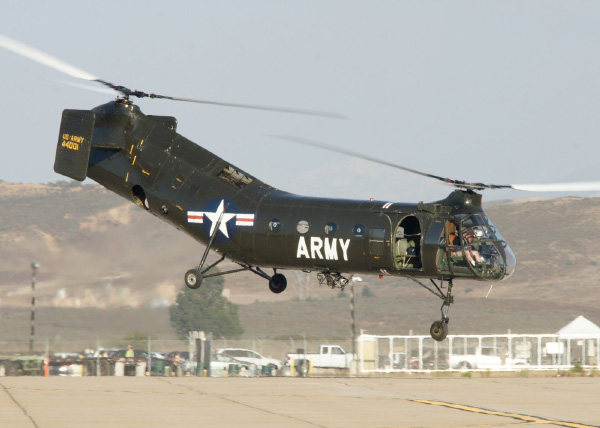 |
||
|
In
terms of aviation, the war in Viet Nam was a blend of the old and the new. While the United States deployed some of the most advanced jet airplanes at the time, such as the F-4 Phantom, helicopters were still largely the domain of piston engines, especially during the early 1960’s. Gas turbine helicopters were on the horizon, but a country has to fight with what it has, during wartime. Accordingly, the piston engine Piasecki (later Vertol) H-21 was the mainstay of the U.S. Army’s combat air assault force early on.
The H-21 was unusual in that it featured two main rotors in a tandem arrangement. Because the two sets of rotor blades overlapped, the fuselage slanted upward at the rear, so that the rear rotor assembly sat higher than the one at the front. Because of the odd fuselage shape, the H-21 is sometimes called “the flying banana”. |
| This concept was the brainchild of helicopter pioneer, Frank Piasecki. As early as 1940, Piasecki, an engineering student at the time, believed that the conventional tail rotor robbed precious power from the engine – power that could be used to help lift the helicopter. To pursue this further, he and some of his fellow students formed a small company – The P-V Engineering Forum, which became Piasecki Helicopter Company in 1946. |
|
After a couple of false starts, Piasecki was able to sell his tandem rotor idea to the U.S. Coast Guard. While the U.S. Navy, which runs the Coast Guard during wartime, believed that helicopters could not carry enough payload to be useful, the Coast Guard was struggling to rescue sailors from the ships that were being sunk by U-boats off the U.S. East coast. Piasecki pointed out that, with main rotors on either end of the fuselage, the helicopter could lift heavier loads, without as much concern for even weight distribution. Plus, more fuselage space could be used for passengers and cargo.
The Coast Guard liked the idea, and the Navy contracted for one test aircraft in 1944. Officially designated XHRP-X, and called “Dogship” (due to its experimental status) by Piasecki’s employees, its engine was mounted in the middle of the fuselage with drive shafts running to the front and rear rotor blades. Despite a few glitches, such as the transmission overheating during one test flight, the Dogship performed well. Flown without its fabric covering during initial test flights, the XHRP-X could hit 95mph and carry 10 men. |
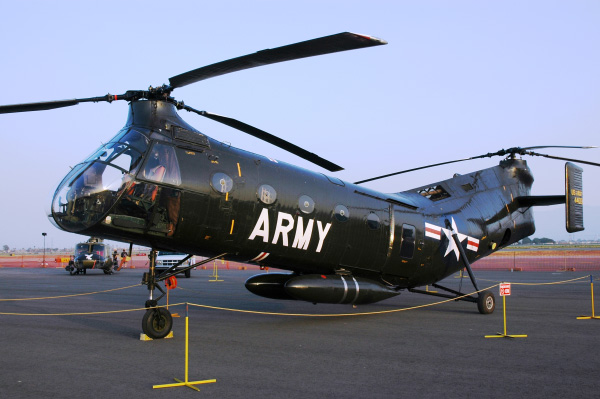
|
|
After its transmission was rebuilt using aircraft-grade parts (the original having used automotive components), testing continued, and twenty HRP-1’s were ordered by the Navy and Coast Guard. Although the Navy “gave” most of its HRP-1’s to the Coast Guard and the Marines, the die was cast, and Piasecki ultimately produced a family of successful tandem rotor helicopters which included the H-21.
Although famous as an Army assault helicopter, the H-21 was originally designed as an Arctic rescue helicopter for the U.S. Air Force. First flying in 1952, the YH-21 prototype was powered by an 1150 hp Wright R-1820 nine cylinder radial engine. The Air Force initially ordered thirty two H-21A Workhorse’s, which were equipped with rescue hoists and heavy duty heating. These helicopters could operate in temperatures as low as minus sixty five degrees Fahrenheit, and many were used to service northern Distant Early Warning (DEW) radar sites. By 1950’s standards, the H-21 was a solid performer, and the Air Force set speed (146mph) and altitude (22,100 ft.) records with it in 1953. Not surprisingly, development of the H-21 continued, with the Air Force acquiring 163 H-21B’s. At the time, the U.S. Army aviation was limited by law to smaller aircraft. The Air Force was expected to pitch in by providing combat assault transportation when needed, and the H-21B was built specifically for this purpose. Powered by a 1425 hp version of the Wright engine, the H-21B could lift twenty troops. It also had self sealing fuel and oil tanks, as well as provision for external fuel tanks. |
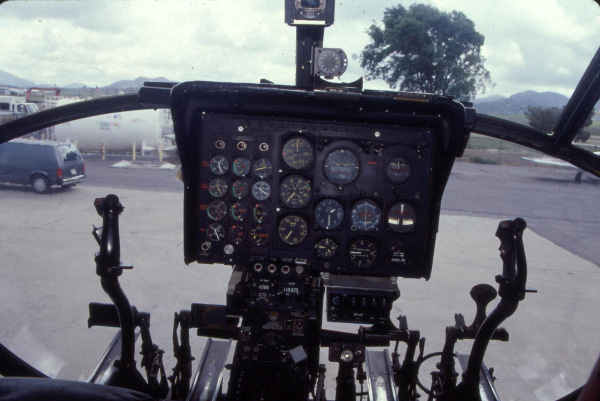
|
|
By the end of the Korean War, the restrictions governing the size of Army aircraft had been eased, and the Army obtained some Air Force H-21B’s. Still, the Army demanded more from its H-21’s. Accordingly, things like a higher useful load and a fuselage - mounted sling that could handle 4,000 lbs. were incorporated into another version, the H-21C "Shawnee". Deliveries began in 1954.
Two years later, the Army scored a “first” by flying an H-21 non-stop across the continental U.S. As exciting as these record-setting flights were, the H-21C’s true value was as a combat air assault helicopter. The Army now had a helicopter that could carry a whole infantry squad. 1961 saw the arrival of the first U.S. Army H-21’s in Viet Nam. Robert J. Brandt flew them as a First Lieutenant with the 33rd Transportation Helicopter Company during his 1962 – 1963 tour of duty and commanded a maintenance detachment. At the time, American forces were not “officially” engaged in combat operations. U.S. troops were supposed to be serving as advisors to the South Vietnamese. Brandt describes the 33rd’s responsibilities: |
| “Each day, we had to have two H-21’s on medevac standby; and then there would be a series of “admin.” missions. The admin. missions primarily involved re-supplying Special Forces advisors out in the field…we would re-supply them with ammunition, C-Rations. And, we would deliver mail and pick up their letters, which we would mail after we got back to Ben Hoa. When medevac missions were called, we scrambled the two aircraft to recover primarily U.S. (personnel) and get them back to Saigon. Because most combat took place in remote areas, quick evacuation of the wounded was critical. “There was an Air Force dispensary in Saigon, and an Army field hospital in Na Trang; basically, in those early days, if a soldier was injured severely, he probably would die.” “If he were lightly wounded, he’d probably survive; with a serious injury, they could only perform limited life-saving surgery in Saigon and then transfer the individual to Na Trang (where there were better facilities); so medevac was pretty important.” |
|
The 33rd also carried SouthVietnamese troops into combat. En route altitude was usually 2,000 feet above ground level, until near the Landing Zone (LZ). At that point, the helicopters – which were later called CH-21’s - would descend to “nap of the earth” altitude. This meant flying 10 to 20 feet above the ground at 100 knots. No doubt an exciting ride, this tactic gave the enemy little time to open fire and maximized the element of surprise. Plus, the pilots would vary their routes in order to throw off the aim of enemy anti-aircraft gunners.
Brandt usually flew the last helicopter in the formation. This way, he and his team could land near downed helicopters and assess the damage. By monitoring the radio, Brandt would get an idea of what awaited him at the LZ: |
| “Each helicopter was designated with a “chalk” number (radio call sign), and that chalk number was taken from the writing on the side of the fuselage of a particular aircraft, so that the soldiers knew which aircraft they were supposed to get on; so if you were (flying) “Chalk Nine, Ten, or Twelve” in the formation going in, and you started hearing that One, Two, and Four were taking fire, you knew that, in seconds, you were going to be in that same place…it kind of caused you to pucker up a little bit!” |
| If a damaged helicopter was salvageable, Brandt would supervise the recovery operation. If not, it was destroyed on the spot. Usually, Thermite grenades were sufficient to accomplish this. Sometimes, however, the Air Force was called in to do the job with some well - placed rockets, napalm, or bombs. |
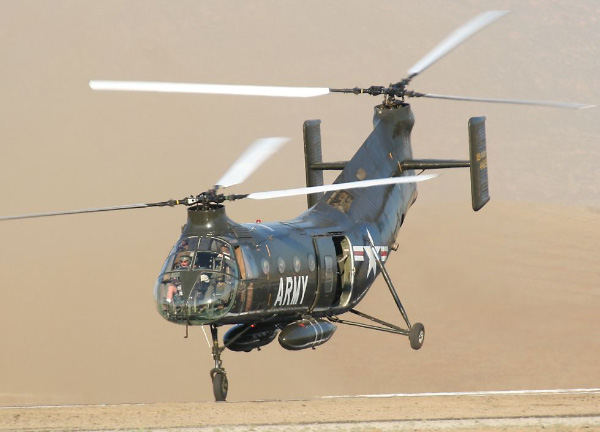
|
|
With no armor plating, and a door mounted machine gun for defense, CH-21’s were vulnerable to enemy fire – especially since the Viet Cong had learned to aim for vital areas.
In spite of this, the crews were sometimes required to fly special missions, such as the harrowing five-helicopter “Eagle Flight” described in Brandt’s book: Thunderbird Lounge (Trafford Publishing, 2001). This mission required Brandt’s unit to carry troops to a village that was occupied by the Viet Cong. ARVN troops were already trying to dislodge the Viet Cong. If called upon by the Forward Air Controller (FAC), who was flying a Cessna O-1 Bird Dog, the orbiting helicopters would land additional troops to block the enemy’s escape routes. Once again, Brandt’s CH-21 was last in the formation. He and his co-pilot, Chief Warrant Officer Bryson “JC” Penny were orbiting a nearby river when the call came. The FAC had spotted retreating Viet Cong south west of the village. The Bird Dog pilot’s voice crackled through on the radio: “You will be landing to the south west, just north of the canal. I will mark with white smoke.” At this point Brandt had his hands full. While JC handled the throttle, Brandt brought the heavily loaded helicopter down for landing in a soggy rice paddy. Besides jockeying the CH-21 into position, Brandt had to contend with turbulence from the rotor wash of the preceding helicopters. He also had to keep from sinking into the mud. Just one stuck wheel could cause the helicopter to tip over, if power was applied too quickly during take off. After touching down, Brandt heard several loud “cracking” noises. Suddenly, several holes appeared in the cockpit Plexiglas right next to him. Feeling pain in his left arm and lower body, Brandt looked around to see who was firing at them and noticed that JC (who, ironically, had recently survived a fiery crash while a passenger in a De Havilland U-1A Otter) was hunched down in his seat. Just outside, a Viet Cong soldier was aiming a rifle directly at the cockpit. They had landed in the middle of the retreating Viet Cong. Brandt yelled at his door gunner to kill the man. The problem was that the gunner could not fire without hitting another CH-21 which had landed nearby. In the meantime, the Viet Cong soldier who had just shot at Brandt and his co-pilot just stood and stared at them. While this curious stand off was playing out, the ARVN troops had gotten out of Brandt’s CH-21 and were now returning fire. With bullets flying all around him, the man finally began to run. Hit before he could get very far, the enemy soldier fell dead; face down in the water. Brandt was lucky. All that kept him from being seriously wounded was the survival kit stowed in the seat bottom. The kit actually slowed the bullet down so that it caused only minor injuries. That day, Brandt happened to be flying the only CH-21 with survival kits still in the pilot’s seats. In the other helicopters, the kits had been moved to the avionics compartment. Generally, the CH-21 served its masters well. However, it was a complex machine. The engine drove the rotors through a system of three transmissions, plus the associated drive shafts, linkages, and accessories. However, CH-21’s real weakness the engine itself. Brandt explains: “The H-21 was a very reliable helicopter; however, the engine was just not designed to be run at the constant high RPM and manifold pressures used in a helicopter.” “It was meant to be used in regular aircraft.” “In a fixed wing aircraft, you go to full power for take off and climb, and then throttle back for cruise flight; in a helicopter, the engine is running near its limit all the time, so it wears out pretty quickly.” Not surprisingly, CH-21’s operating under the hot, dusty conditions found in Viet Nam required engine overhauls after only 150 hours of use. Careless operation could be costly as well. In his book, Brandt points out that the engine had to be running smoothly at 800 rpm before the rotors could be engaged. With no load on it, the engine could easily over speed. If this happened even once, the engine would have to be re-built. When it was time to engage the rotors, engine RPM had to be slowly increased from 800 to 1300 rpm. While opening the throttle, the pilot had to flip a switch which activated the friction clutch. The friction clutch gradually connected the rotors to the drive train. With this done, the pilot would engage the jaw clutch mechanism, which fully connected the rotor system. Sometimes, the system bypassed the friction clutch and went directly to the jaw position by itself. When this happened, the rotors (which were hollow and covered by a thin veneer of mahogany) would shatter from the sudden acceleration to high RPM. The danger to anyone standing near the helicopter is obvious. This is why the crew chief had to crouch under the cockpit until the rotors were fully engaged. He would then check the outside of the helicopter for fluid leaks and climb aboard. |
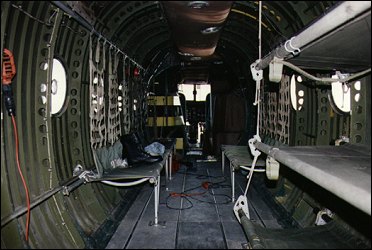
|
|
Being a helicopter, the CH-21 was fully capable of taking off vertically. Nevertheless, pilots sometimes made rolling take offs to avoid excessive turbulence during the transition from vertical to forward flight. This was also easier on the engine. During a rolling take off, the CH-21’s tail would lift off first. Seeing a helicopter rolling down the runway with its tail in the air must have been a funny thing!
By the mid 1960’s, the jet powered Bell UH-1 “Huey” was being phased into Army service. Although a modern design, the Huey did not completely replace the CH-21, initially. For one thing, the Huey was designed primarily as a Medevac helicopter, and it could only carry 4 or 5 troops. If needed as a troop transport, this deficiency could be made up for by simply deploying more UH-1’s. As Gen. Brandt points out, though; the problem with this approach was that the “integrity” of infantry platoons and squads would be disrupted, because the men would be flying in separate helicopters. The CH-21 was the only helicopter in the U.S. Army’s inventory that could carry a complete infantry squad. As a result, operations were conducted with mixed formations of CH-21’s carrying troops, and Hueys flying armed escort. According to Jane's American Fighting Aircraft of the 20th Century, operation of the CH-47A by the VNAF began in 1971, but deliveries of the CH-47B (presumably to the U.S. Army) began in 1967. So, there was a 2 year gap between the retirement of the CH-21 from front line service and the arrival of the CH-47 in the Army inventory. The departure of the CH-21 left a gap that would not be filled until deployment of the CH-47 to Viet Nam. Presently, the Army’s air assault strategy is now supported by the Sikorsky UH-60 Blackhawk. Over 700 H-21’s were produced. One hundred, fifty of them were sold to foreign governments, including those of Sweden, West Germany, France, Japan, Burma, and Canada. Some of these foreign H-21’s served well into the 1970’s. As for Piasecki Helicopter Company; it became Vertol Aircraft Corporation shortly after Frank Piasecki left the firm in 1956. Vertol continued Piasecki’s tandem rotor line, producing the gas turbine powered CH-46 for the U.S. Navy and Marine Corps, as well as the CH-47 Chinook for the U.S. Army. Vertol evolved into Boeing Helicopter Company, which is which is currently building an updated version of the CH-47 for both the U.S. Army and Air Force. After he left his helicopter company, Frank Piasecki started another firm which is in business to this day. This company, Piasecki Aircraft Corporation, has pursued the development of advanced vertical – lift aircraft and is noted for conducting the flight (in 2006) of the world’s first auto gyro UAV. Few people today will ever hear the clatter of an H-21 as it passes overhead. Piston-engine heavy lift helicopters have long been replaced by more powerful gas – turbine types. Nevertheless, the (C) H-21 did what was asked of it, even under the most trying of conditions. The family resemblance between the current Boeing CH-47 and the old Piasecki/Vertol CH-21 is a testament to the success of Frank Piasecki’s idea, as well as his foresight. |
| Specifications: | |
|---|---|
| The Piasecki CH-21C | |
| Dimensions: | |
| Rotor span: | 44 ft 0 in (13.40 m) |
| Length: | 52 ft 6 in (16.00 m) |
| Height: | 15 ft 9 in (4.80 m) |
| Weights: | |
| Empty: | 8,950 lb (4,058 kg) |
| Max Gross: | 15,200 lb (6,893 kg) |
| Performance: | |
| Maximum Speed: | 127 mph (204 km/h) |
| Cruise Speed: | 100 mph (163 km/h) |
| Inclined Climb: | 1,600 ft/min (488 m/min) |
| Service Ceiling: | 9,450 ft (2,880 m) |
| Range: | 265 miles (426 km) |
| Powerplant: | |
| One Wright R-1820-103, 1,425 hp engine, (1,063 kw) 9-cylinder, radial, air cooled. | |
| Armament: | |
| Twin or quad .50 machine guns. | |
|
The author Scott Schwartz is a freelance writer who lives in Southern California. His articles have appeared in several publications, including Flight Journal magazine, and he writes a monthly aviation history column for In Flight USA. Readers can visit his web site: www.sandNskyphoto.com. |
©Scott Schwartz The Aviation History Online Museum.
All rights reserved.
Created November 4, 2009. Updated November 18, 2013.